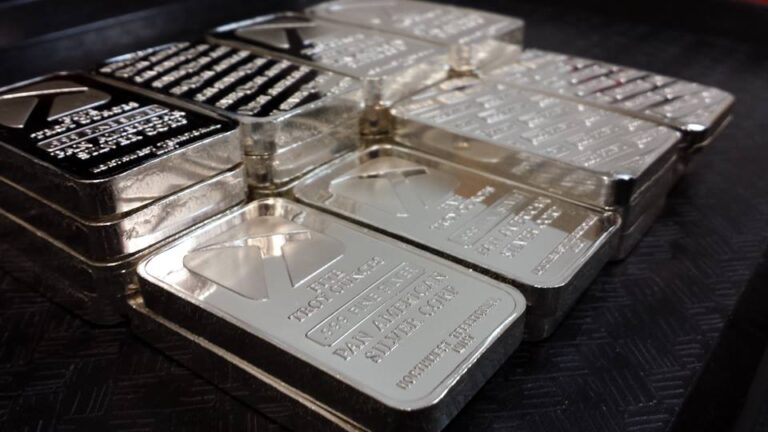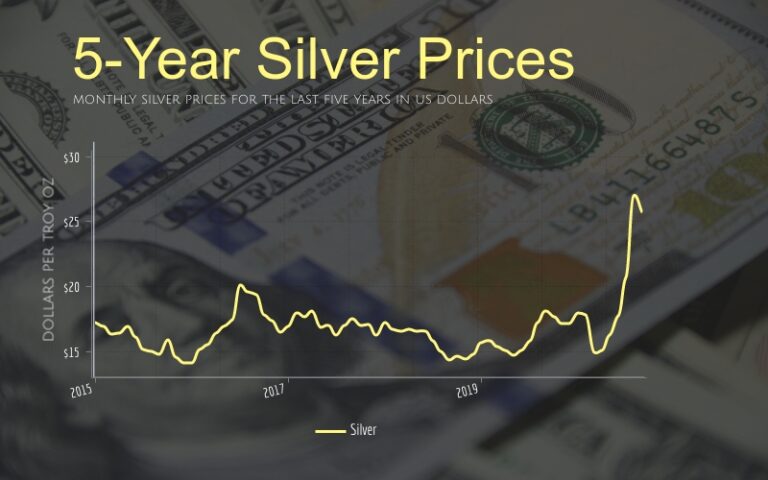Silver Price Per Ounce Today

Silver is a precious metal with an extensive history of use in currency and jewelry. It is considered to be one of the world’s most important metals due to its wide range of industrial applications and consumer demand.
As such, it is important for investors to understand the current silver price per ounce, as well as the factors that influence its value. This article will discuss the current silver price per ounce, what influences it, historical changes in its value, and predictions for future trends.
What Is the Current Silver Price Per Ounce?
At this juncture, the value of a standard troy ounce of the precious metal is being examined.
Silver is a valuable precious metal that has been used for trade and currency since ancient times.
It has seen more variations in its price than gold and can be volatile on the market depending on several factors such as supply and demand, economic conditions, geopolitical events, and other global influences.
Currently, silver is trading at around $27 per troy ounce in US dollars. Prices can vary slightly from day to day due to fluctuations in the markets.
Investors often watch silver prices closely to gauge where it may move next while holding onto physical bullion or futures contracts as a hedge against inflation or currency devaluation.
Silver remains an important asset class for investors looking to diversify their portfolios and guard against risk.
What Factors Influence the Silver Price?
Various factors can have an impact on the current market value of precious metals, including silver. It is important to note that such price fluctuations can be affected by both short and long-term forces.
Short-term influences include daily supply and demand, as well as changes in interest rates.
Long-term factors include inflationary expectations, economic growth forecasts, geopolitical tensions, and currency exchange rate fluctuations.
The demand for silver in industry also plays a role in setting its market value. Silver is used in a variety of industries, ranging from solar energy production to glassmaking and electronics manufacturing.
As these industries become more competitive or experience downturns due to external forces such as economic recessions or natural disasters, the demand for silver can rise or fall accordingly.
In addition to industrial applications, investors often buy silver coins and bullion when they expect prices to increase over time; this additional investment reinforces the strength of the market for silver at any given moment.
Historical Changes in the Silver Price Per Ounce
Over time, the value of silver has experienced significant fluctuations, with its price per ounce rising and falling in response to various economic and political factors. In particular, the market for silver has been known to be volatile due to its finite supply, making it highly sensitive to changes in demand.
During periods of economic prosperity or increased demand, prices have risen sharply. Conversely, when global economies suffer downturns or recessions, prices can drop dramatically as a result of decreased demand.
From a historical perspective, the price of silver per ounce was relatively steady until the mid-1970s when it began an upward trend that lasted until 2011. This period saw an enormous surge in silver prices due to high levels of investment interest and speculation driven by strong economic growth around the world during this time period.
However, since 2011 silver prices have been slowly declining and remain below their peak levels from a decade ago as global markets continue to experience volatility and uncertainty.
The Impact of Silver Price Fluctuations on Investors
Fluctuations in the value of silver can have a major impact on investors due to its finite supply and sensitivity to demand. Silver has become a popular investment for many people, as it can be more affordable than gold or stocks while still providing potential financial rewards.
When the price of silver increases, investors may benefit from increased profits or gains, allowing them to recoup losses that may have been incurred during market downturns. Conversely, when the price of silver decreases, investors may suffer significant losses due to their investments being worth less than when they were purchased.
Investors must carefully consider their options when deciding whether or not to invest in silver. They should take into account the current and future market trends before making any decisions regarding their investments. Furthermore, investors should monitor the news surrounding silver prices in order to anticipate any changes that could potentially affect their investments.
By understanding how these fluctuations can influence their investments, investors can make better informed decisions and hopefully achieve greater success with their investments in the long term.
Predictions for Silver Price Per Ounce in the Future
Accurately predicting the future value of silver per ounce can be difficult due to its susceptibility to global economic and political influences. While many analysts seek to forecast the price of silver, it is ultimately impossible to determine the exact value that it may hold in the future.
It is, however, possible to identify trends in price movements by examining prior data and observing current market conditions. For example, an analysis of historical data reveals that investors have tended to buy silver when other asset classes become overvalued or when inflation increases. Additionally, macroeconomic events such as natural disasters or shifts in currency values can also lead to changes in the price of silver per ounce.
Therefore, while there is no guarantee for what will happen with regard to silver prices in the future, understanding how external factors can affect the market can help investors develop more informed predictions about potential outcomes.
Frequently Asked Questions
What is the best way to buy silver?
When looking into the best way to buy silver, it is important to consider the benefits and drawbacks of purchasing in different quantities. An interesting statistic to note is that buying silver in bulk can often yield a lower overall cost per ounce than buying smaller amounts at multiple points in time.
The primary reason for this is that most dealers offer discounts on larger orders as a way of incentivizing customers. Additionally, many investors find it more convenient to purchase large amounts all at once rather than repeatedly making small purchases over time.
When deciding on how much silver to buy, one should consider their budget and needs before taking action.
What is the difference between silver and gold prices?
Silver and gold are two of the most valuable precious metals in the world, and their prices often move in relation to each other.
Generally, gold is more expensive than silver because it is rarer and more valuable due to its malleability, ductility, lustre and colour. Gold also has a higher intrinsic value due to its historical use as a form of currency.
However, market forces such as supply and demand can cause silver prices to be higher than that of gold at any given time.
Ultimately, the difference between gold and silver prices is determined by a variety of factors including market conditions, production costs, geopolitical events and investor sentiment.
How does the silver market compare to other markets?
Comparing the silver market to other markets, it is clear that its volatility offers a unique investment opportunity.
Like the shifting sands of a desert, the value of silver can quickly rise and fall with speculation or economic changes.
This makes it an attractive option for those looking to make short-term investments as the potential rewards are often high.
However, due to its unpredictability and volatile nature, long-term investments in silver may be risky and should be made with caution.
What are the tax implications of investing in silver?
Investing in silver can have tax implications depending on the type of investment and where it is located.
Silver investments such as coins, bars, or rounds are typically subject to capital gains taxes when sold at a profit.
Taxation of silver investments may also be applicable depending on the jurisdiction in which they are held. For example, some states levy sales taxes on precious metals like silver when they are purchased.
Individuals should research their local laws regarding taxation of silver before investing to ensure they understand any potential implications for their investments.
Are there any ethical considerations when investing in silver?
Investing in silver has become increasingly popular over the past few years, and with it comes the need to consider ethical considerations.
Many investors have raised concerns about the environmental impact of mining operations, since they may involve deforestation or pollution.
Additionally, there are questions of labour rights and corporate responsibility when dealing with companies that produce silver.
The industry is further complicated by geopolitical factors such as government regulations or sanctions which can affect prices and availability.
For these reasons, it is important for investors to examine their personal values before deciding whether investing in silver is a viable option.
Conclusion
The silver market is an ever-changing landscape, and the price of silver per ounce reflects that. Prices can rapidly increase or decrease due to a variety of factors, making it difficult for investors to stay on top of their investments.
Despite this volatility, the long term trend shows an overall increase in the value of silver over time. While no one can predict future prices with absolute certainty, investors should be prepared for significant fluctuations in the silver price per ounce as they seek to maximize their returns.
Ultimately, understanding how changes in the market affect silver prices is essential for successful investing.






